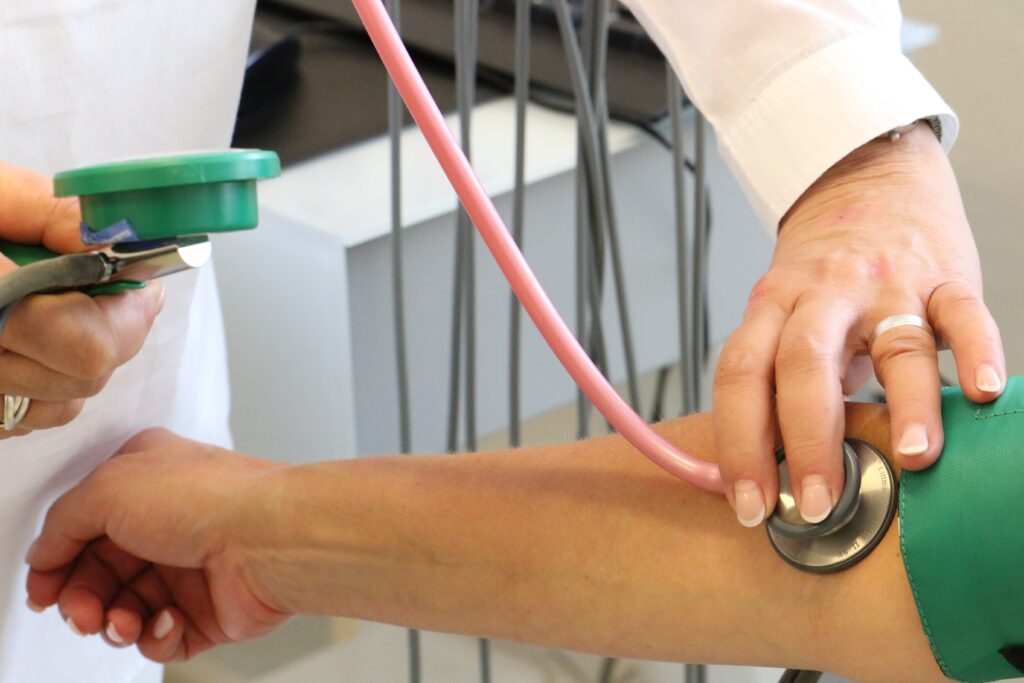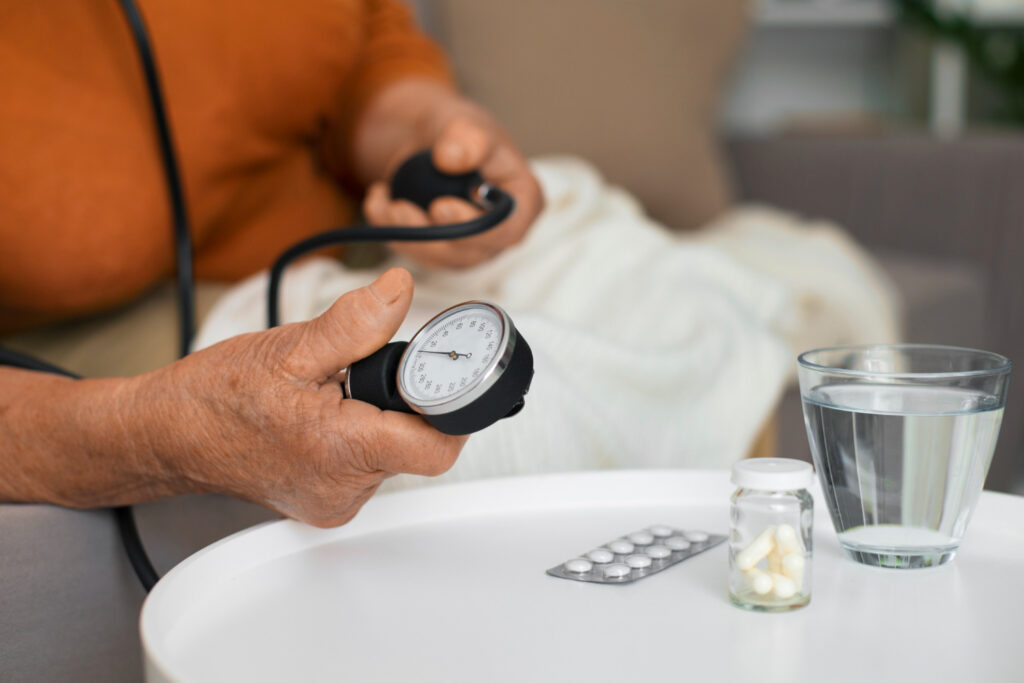
Table of Contents
Overview
Blood pressure, often referred to as the “silent killer,” is a crucial measure of your overall health. However, the accuracy of this measurement can be significantly influenced by something as simple as the position of your arm during the reading. Many people, including healthcare professionals, may overlook this detail, but research has shown that improper arm positioning can result in higher readings. This, in turn, can lead to misdiagnosis, unnecessary medication, and potential harm to your health.
In this blog post, we will delve into why arm position is so important in blood pressure measurement, explore the findings of a recent study, and provide tips on how to ensure accurate readings. Understanding these small yet vital factors can help prevent overdiagnosis and the potential consequences of incorrect blood pressure management
Why Arm Position Matters in Blood Pressure Measurement
A recent study published in JAMA Internal Medicine by researchers from Johns Hopkins University underscores the significant impact of arm positioning on blood pressure readings. The study revealed that an incorrect arm position can elevate both systolic (the top number) and diastolic (the bottom number) blood pressure readings by up to 7 points.
For instance, when the arm is not supported at heart level, the systolic reading can increase by 6.5 points if the arm is hanging by the side, and by 3.9 points if it is resting in the lap. This difference may seem small, but when you consider the categories of blood pressure, these few points could be the difference between a normal reading and a diagnosis of hypertension
Related : how to control high blood pressure through diet
Here are the general blood pressure categories:
- Normal: Less than 120/80 mmHg
- Elevated: Systolic 120-129 mmHg and diastolic less than 80 mmHg
- Hypertension Stage 1: Systolic 130-139 mmHg or diastolic 80-89 mmHg
- Hypertension Stage 2: Systolic 140 mmHg or higher, or diastolic 90 mmHg or higher
For example, if your true blood pressure is 134/82 mmHg (Stage 1 hypertension), but incorrect arm positioning causes a false reading of 140/85 mmHg, you may be diagnosed with Stage 2 hypertension, which could lead to unnecessary medication and treatment. These errors in measurement have serious implications, as high blood pressure is a leading cause of heart attacks, strokes, and other cardiovascular diseases
The Study: Exploring the Link Between Arm Position and Blood Pressure
The study, led by Dr. Tammy Brady at Johns Hopkins University, involved 133 participants aged 18 to 80, each undergoing blood pressure checks in various arm positions. The researchers found that measurements taken with the arm unsupported (either hanging by the side or resting in the lap) were consistently higher than those taken with the arm properly supported at heart level. This underscores the importance of correct technique when measuring blood pressure, whether you’re in a clinical setting or taking readings at home.
The study also pointed out that even healthcare professionals sometimes fail to properly position the patient’s arm during a blood pressure check. This lack of awareness can lead to inflated readings and unnecessary prescriptions. Dr. Brady emphasized that both doctors and patients need to be aware of how these seemingly small details can affect outcomes
Related : Top Foods to Avoid if You Have High Blood Pressure
The Dangers of Overdiagnosis Due to Misreadings
Blood pressure misreadings, particularly those that result in higher readings, can lead to overdiagnosis of hypertension. Overdiagnosis, in this context, means that a person may be diagnosed with high blood pressure when their condition is not as severe or even present. This can have multiple negative effects, including
- Unnecessary Medication: A higher blood pressure reading could lead to a prescription for antihypertensive medications that you might not need. These medications often come with side effects such as dizziness, fatigue, headaches, and sometimes more serious issues like kidney problems. Taking medication unnecessarily increases the risk of experiencing these side effects without the benefits of treating a real condition.
- Health Anxiety: Misdiagnosed patients may develop health-related anxiety, constantly worrying about their blood pressure and cardiovascular health. This anxiety can exacerbate health problems, leading to a cycle of stress, which, ironically, can increase blood pressure.
- Increased Healthcare Costs: Misdiagnosis can lead to more frequent doctor visits, tests, and treatments, all of which contribute to higher healthcare costs. These expenses could be avoided with accurate measurements.
Best Practices for Accurate Blood Pressure Measurement
To avoid the risks of overdiagnosis, it’s essential to follow proper procedures when measuring blood pressure, whether in a healthcare setting or at home. Here are some best practices
Related : Worst Foods for High Blood Pressure
- Support Your Arm at Heart Level: Always ensure that your arm is resting on a hard surface at heart level. This will provide an accurate reading by reducing any strain on your arm, which can artificially inflate the numbers.
- Sit in the Correct Position: Make sure you’re sitting with your back supported, feet flat on the ground, and legs uncrossed. Poor posture can affect your blood pressure reading by compressing arteries or creating tension in your body.
- Relax Before Taking a Reading: Rest for at least 5 minutes in a quiet, calm environment before taking your blood pressure. If you’re rushing or stressed, your reading may be higher than your true resting blood pressure.
- Avoid Caffeine, Exercise, and Smoking Before the Test: These factors can temporarily raise your blood pressure. Make sure to wait at least 30 minutes after consuming caffeine, smoking, or exercising before checking your blood pressure.
- Use the Right Cuff Size: Using a cuff that is too small or too large for your arm can result in inaccurate readings. Most home blood pressure monitors come with adjustable cuffs, but it’s important to check that the cuff fits properly around your upper arm.
- Take Multiple Readings: Blood pressure can fluctuate throughout the day, so it’s a good idea to take several readings and average them out for a more accurate picture of your health. Take at least two readings, one minute apart, and consider doing this at different times of the day
Related : Foods that Help Lower Blood Pressure
The Role of Healthcare Providers in Ensuring Accurate Readings
Healthcare providers play a critical role in ensuring that blood pressure readings are accurate. Unfortunately, the hustle and bustle of busy clinics can sometimes lead to rushed measurements, which may not follow the best practices outlined above. As a patient, you have the right to advocate for your own health by asking for proper arm support and ensuring that the reading is taken correctly.
Dr. Karyn Singer, an expert in chronic disease prevention, emphasizes the importance of patients speaking up. “Many times, patients don’t question the technique used by their healthcare providers. If something feels off, such as your arm being unsupported, it’s okay to ask the nurse or doctor to adjust their method. After all, it’s your health at stake.”
Additionally, Dr. Matthew Tomey of Mount Sinai Hospital stresses the need for healthcare providers to adhere to these guidelines, especially when treating older adults or individuals with a history of cardiovascular disease. “Small errors in measurement can have outsized impacts, particularly in at-risk populations,” he says.
Monitoring Blood Pressure at Home: Tips for Success

Home blood pressure monitoring is becoming more common, particularly for individuals managing hypertension. If you’re taking your blood pressure at home, the same rules apply—proper arm positioning, correct posture, and using a good-quality monitor are all essential for accurate readings.
It’s also crucial to keep a log of your readings and bring this information to your healthcare appointments. This will help your doctor get a fuller picture of your blood pressure trends over time and make more informed decisions about your treatment plan.
Dr. Megan Kamath, a cardiologist at UCLA Health, advises that patients should not rely solely on a single reading. “Blood pressure can vary depending on various factors, including stress, diet, and time of day. A consistent log of home measurements can provide invaluable insights into a patient’s health, helping to prevent both over- and underdiagnosis
The Takeaway
The simple act of ensuring your arm is properly supported during a blood pressure reading can have a profound impact on your health. Incorrect readings due to poor positioning can lead to overdiagnosis of hypertension, unnecessary medication, and a host of other issues. Both healthcare providers and patients need to be aware of the correct procedures for measuring blood pressure and should work together to ensure that readings are as accurate as possible.
For patients, this means being proactive—don’t hesitate to ask questions, request retakes, or clarify the method being used to measure your blood pressure. For healthcare providers, it means staying vigilant in following best practices, educating patients, and ensuring that their methods align with current guidelines.
By following these guidelines, you can ensure that your blood pressure readings are accurate, and your health is managed correctly, without the unnecessary risks of misdiagnosis and overtreatment. Accurate blood pressure management is a key factor in preventing serious health conditions and maintaining overall wellness.
Taking the time to get your blood pressure checked properly is a small but crucial step toward ensuring long-term health and avoiding the pitfalls of incorrect readings
Frequently Asked Questions
- Why does arm position matter during blood pressure measurement?
Arm position affects blood pressure readings because when the arm is not properly supported at heart level, it can lead to artificially higher measurements. Unsupported arms increase muscle tension and stress on blood vessels, skewing the results.
- How much can improper arm positioning affect blood pressure readings?
Research has shown that improper arm positioning can increase systolic blood pressure by up to 6.5 points and diastolic by up to 3.9 points. Even small differences like these can lead to a misdiagnosis of hypertension.
- What is the correct position for taking a blood pressure reading?
The arm should be fully supported at heart level, with the person sitting upright, back supported, feet flat on the ground, and legs uncrossed. The arm should rest on a firm surface, like a table, for the most accurate reading.
- What are the risks of incorrect blood pressure readings?
Inaccurate blood pressure readings can lead to overdiagnosis, unnecessary medication, health anxiety, and higher healthcare costs. Misdiagnosis could lead to side effects from medications that you may not need.
- How can I ensure I’m getting an accurate blood pressure reading at home?
To ensure accurate home readings, follow these tips: rest for 5 minutes before the test, avoid caffeine or smoking 30 minutes prior, sit in the correct position with your arm supported at heart level, and take multiple readings to account for fluctuations.
- Can I ask my healthcare provider to retake my blood pressure if I think the reading was incorrect?
Yes, you have the right to ask for a retake if you feel the measurement was not done correctly. Proper technique is important for accurate readings, and it’s essential to advocate for your health by ensuring best practices are followed.











